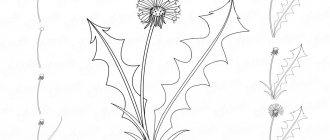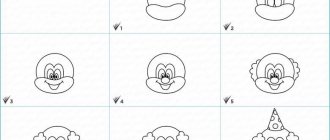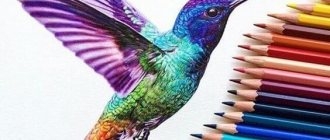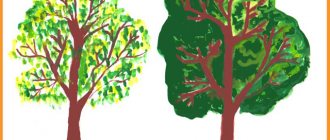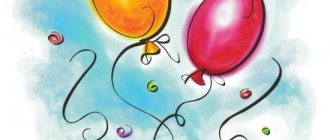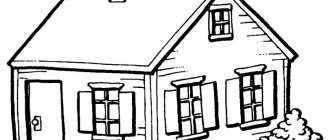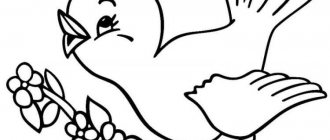Stages of drawing a birch tree for beginners
For the lesson, it is enough to prepare a landscape sheet, a simple medium-hard pencil and an eraser.
It is recommended to draw a lonely birch tree on a sheet located vertically. Then it is not difficult to place it entirely. If several trees are depicted, then the leaf can lie both vertically and horizontally.
For children, before drawing a birch tree, the lesson begins with determining its place on the sheet. So that the tree does not look torn from the ground, the same distance is removed from the upper and lower edges of the leaf. The same should be done with the side borders.
For a beginning artist, step-by-step progression will make the task easy.
1. Work begins with drawing a birch trunk.
It does not prevent children and adults from remembering that a birch tree is always compared to a slender girl. Therefore, the table cannot be too thick. But still it is thicker at the bottom and tapers towards the top. Moreover, the peculiarity of birch is the bifurcation of the top of the birch.
2. Any tree has longer lower branches. They are thicker than the top ones. From the middle of the trunk to the crown, the branches are drawn evenly. Then the birch will be harmonious.
The trunk with the main branches is depicted first. Thin branches are already being drawn onto them. The top ones are directed towards the sun. And the lower they are, the more the branches smoothly fall down. They are said to have a weeping shape. The more small branches, the fluffier the birch will be.
3. The stains characteristic of birch are applied directly to the trunk. The lower first three main branches are decorated with small dash stripes.
It is also important for an artist to be observant. This quality will tell you how to correctly draw birch bark on the branches and trunk. If its trunk is white, then its branches are dark. To color them, a dark brown color is chosen. On the tree, the branches are not located strictly on the sides. Their image around the trunk will make the drawing more realistic.
Poems about birch for children
No other tree has the honor of being sung in so many beautiful verses at once. It is impossible not to love this elegant and sophisticated tree with all your heart and not to dedicate your works to it. She inspires and serves as a muse. It was sung by such famous poets as Yesenin and Balmont, Fet and Rubtsov, as well as many others.
"Birch Grove"
German Khodyrev
Whiter than pure snow And the radiant moon, Like a maiden in white dresses, The birch trees stood in a circle.
Their branches are thin arms, as if they were sonorous strings. Only the wind touches them - And everything around them sings.
In the clear light of the month the whole grove seems to glow. And less often the twilight of the evening, the shadow lighter than the night.
And the mighty, thick forest looks at the grove joyfully: Now the bright day is always shining next to it.
"Birches"
Najmi Nazar
...Sometimes white, sometimes whitish, Above the field, highway or river, Generous birches, What nation are you? Which?
Yes, none. After all, you are trees. And hearts should be rejoiced by the fact that you are alien to arrogance and do not change your face...
The verse about the birch tree by Sergei Yesenin, known to everyone from school, touches the most tender strings of the soul...
"Birch"
S. Yesenin
The white birch tree under my window is covered with snow, like silver.
On the fluffy branches, like a snowy border, brushes blossomed like a white fringe.
And the birch tree stands in sleepy silence, and snowflakes burn in golden fire.
And the dawn, lazily going around, sprinkles the branches with new silver.
"Berezka"
S. Shchipachev
The downpour bends her to the ground, Almost naked, and she rushes, looks silently - And the rain subsides at the window.
And on an impenetrable winter evening, Believing in victory in advance, The snowstorm takes her by the shoulders, Takes her white hands.
But, thin, breaking her, they will be knocked out of strength... She, apparently, has a straight character, is faithful to someone else.
"Birches"
Again about them, Curly and whitish... And what to do here, If in Rus' there are birches along all the roads, At least a day, At least a year, At least an eternity of wheels. Anything happened: they cut down our own people, and they took axes to foreigners. Showers of juice poured into funnels, And piles of mutilated bark...
They stand, bordering the roads, And weaving and weaving their green canopy... And my Rus' is a birch grove, Which cannot be cut down forever!
"Sad Birch"
A. Fet
A sad birch tree is at my window, And at the whim of the frost it has been dismantled.
Like bunches of grapes, the ends of the branches hang, - And the whole mourning outfit is joyful to look at.
I love the game of the Lucifer I notice on it, And I feel sorry if the birds shake off the beauty of the branches
"Birch"
I. Tokmakova
If they gave the birch a comb, the birch would change her hairstyle: Looking into the river, as if in a mirror, she would comb her curly strands, and it would become a habit for her to braid her hair in the morning.
I love Russian birch
A. Prokofiev
I love the Russian birch tree, sometimes bright, sometimes sad, in a bleached sundress, with handkerchiefs in its pockets. With beautiful clasps. With green earrings. I love her, elegant, dear, beloved, now clear, ebullient, now sad, weeping. I love the Russian birch tree, She always dances with her friends in the spring, Kisses, as usual, Walks where it is not fenced, Sings where it is not supposed to, Bends down in the wind And bends, but does not break!
"Birch"
K. Balmont
My dear birch, with a silver trunk, I missed you in the tropical thickets. I missed the lilacs in bloom, and about him, the vociferous nightingale, About everything that I married with a dream as a child. I was there far away, In the multi-colored spice of lush, jubilant countries. There, the ominous cougar narrowed its eye with hostility, And before a quick thunderstorm, the roar of the monkeys deafened me. But, quietly swaying, On a heavy, alien, Mexican saddle, I dozed in my soul, and, blooming airily within me, My birth shadows rose in the silver darkness. Oh, spring thunderstorms! Childhood with a branch of lilac, in the evening silence of nightingales, The swell and whisper of the foliage of this cute weeping birch, The enchantment of dreams - only once blooming days!
“A thin birch tree, a teenager between the birches...”
Samuel Marshak
A thin birch tree, a teenager between the birches, Admiring himself on an April day, Looking at the blurry trail of large wheels, Where the blue sky is reflected.
"Birches"
N.Rubtsov
I love when the birches rustle, When the leaves fall from the birches. I listen and tears come to my eyes, weaned from tears.
Everything will come to memory involuntarily, It will respond in the heart and blood. It will become somehow joyful and painful, as if someone is whispering about love...
My Rus', I love your birches! From the first years I lived and grew up with them. That’s why tears come to eyes weaned from tears...
"I am the last poet of the village"
S. Yesenin
I am the last poet of the village, The plank bridge is modest in songs. At the farewell mass of the birch trees burning with leaves.
I remember the autumn nights, the birch rustle of shadows, even though the days were shorter then, the moon shone for us longer.
I left my home, I left Blue Rus'. The three-star birch forest above the pond warms the old mother's sadness.
"First snow"
V.Bryusov
Silver, lights and sparkles - A whole world made of silver! There are birch trees surrounded by pearls, black and bare yesterday...
Dreams come true, Life is a game of dreams, This world of enchantment, This world of silver!
"Good morning!"
S. Yesenin
... The sleepy birch trees smiled, their silk braids disheveled. Green earrings rustle, And silver dews burn...
"First sheet"
F. I. Tyutchev
The leaf turns green young. Look how the birch trees stand covered with young leaves, with an airy green through-and-through, translucent like smoke... For a long time they dreamed of spring, of spring and golden summer, - And now these living dreams, Under the first blue sky, suddenly made their way into the daylight...
"Golden Grass"
A.Barto
On a summer day We walk along the edge of the forest looking for healing herbs. Help us, curly birch, reveal to us the secret of the forest: Where can we get healing sap? Where can I find Golden Herb?
And the tall Birch whispered, As if in a fairy tale And as if in reality: “Look in the oak groves And in the groves with all the crowd, And they will ask you for herbs, So that they can take them with you.”
From the poems of E. Trutneva
...Birch trees, as if on a holiday, put on earrings. The elderberry has gathered to bloom and grow. Where, starlings, did you take the sparrows? There they are! Back in the nest by the window...
...In the thick of the garden on a birch tree, a branch trembled slightly, - There is a redstart hiding under a leaf from a hawk...
... Cautious birch trees hide their leaves from the frost: Suddenly the old man will come again! He's cold, he's used to joking...
...And a leaf from a birch tree, like a golden bee, curls and flies over the thorny tree...
There is hardly a person indifferent to the beauty of birch. Perhaps this is the tree most sung by poets. Birch is a symbol of the Motherland and tenderness.
Winter birch
For winter, a drawing of a birch tree without leaves will be taken as the basis for coloring. There are many options for how to paint a winter birch tree. The simplest one is using a wax candle. To ensure that the wax is applied well to the entire image, small branches are not drawn too small.
1. With strong pressure on the candle, outline the trunk and all branches.
Wax lines on the sheet are visible at a certain angle. This will help you not miss a single branch. Snowflakes in the air and snowdrifts under a tree are drawn with wax.
2. Before you start painting with watercolors using the wet-wet technique, the entire sheet is moistened with water. To do this, use either a wide brush or foam rubber.
3. The entire sheet is filled with paints, moving down in multi-colored horizontal lines. By making smooth transitions from one color to another from top to bottom, it is possible to convey the color of the sky and dawn. At the same time, a snow-covered birch tree appears on the sheet. Children of any age are interested in watching this trick.
MAGAZINE Preschooler.RF
State budgetary educational institution of Moscow "Gymnasium No. 1519" Summary of an open lesson on teaching drawing to preschool children Prepared and conducted by: teacher Samoshkina Elena Gennadievna Moscow 2014 Summary of a lesson on teaching drawing to preschool children. A number of studies devoted to the study of the developmental characteristics of children with mental retardation have noted specific developmental features that complicate the formation of visual activity. Such a disorder is characterized by a lag in the development of the emotional-volitional sphere, higher mental functions, motor sphere, and a decrease in the child’s knowledge and ideas about the world around him. Among such features we can highlight: the qualitative-dynamic originality of gnostic processes (slowing down the reception and processing of sensory information) and underdevelopment of the visual-spatial function; some features of psychomotor development (impulsivity, emotional instability, increased fatigue and exhaustion); lack of sensory integration and coordination makes it difficult to recognize objects and connect individual parts of a picture into a single semantic image; lag in motor development due to problems of muscle tone, immaturity of movement technique, lack of motor qualities, dysregulation of voluntary movements; decrease in the volume of short-term and long-term memory; disadvantages of the voluntary sphere (difficulty concentrating, switching attention, maintaining a task, working according to a model and instructions); general decrease in motivation for activity. Having considered the above-mentioned features of the development of children with mental retardation, it becomes clear that this work should be built using methods of correctional pedagogy and be purposeful. An important feature of teaching children with mental retardation is an integrated approach, which should include several areas: - diagnostic study of the child upon admission to the group to establish the characteristics of his development, clarify his starting capabilities and determine the learning conditions adequate to the structure of the disorders; establishing feedback with the pupil’s family for the purpose of consulting and collecting additional data about the child; interaction with a neurologist (psychoneurologist) to monitor health status; organizing classes according to a combined principle in such a way that several diverse tasks of development, education and training are solved within the framework of one lesson; conducting differentiated training, preliminary individual assistance before group classes, differentiation of assistance within the group; building training on a concentric principle; use of game motivation in all classes; control of psychophysical load both in intensity and duration, and in the sequence of presentation of tasks (intellectual and motor load, phases of active work and relaxation). When teaching children with mental retardation of preschool age, it is important to take into account their age and specific characteristics; the leading role in training should belong to the teacher. Theme “Autumn Birch” (preparatory group) Program objectives: continue to teach children to understand the content of the story. To develop children's attention and observation skills. Activate children's speech with figurative expressions and comparisons. Practicing the skill of question-and-answer speech. Practice relieving tension and being able to relax. Educational work. Learn to convey in a drawing the characteristic features of a birch (white trunk with black spots, thin curved branches, light crown), autumn color of foliage; teach the correct methods of using a semi-dry hard brush when drawing vertical strokes to depict foliage and horizontal strokes to depict black spots on a birch trunk; consolidate the skills of drawing thin curved lines with the end of a brush; through riddles, illustrations, drawings, to form in children’s minds the image of a slender white-trunked birch. Material. The teacher has an illustration with a picture of a birch, a sheet of paper to show individual methods of depiction, two brushes - soft and hard, and paints. Children have blue paper of saturated color in the form of an elongated rectangle, additional sheets of white paper for exercises in drawing thin lines and different ways of working with a hard brush; soft and bristle brushes, gouache paints. Progress of the lesson. The teacher hangs an illustration with a picture of a birch with the back side facing the children and says: “In this picture there is a tree that we will draw. But we’ll look at it after you guess two riddles about it.” A Russian beauty is standing in a clearing in a green blouse and a white sundress. When the children name the answer, he asks: “What is the name of the birch tree in this riddle? Why is she called a Russian beauty? What is the name of the birch tree's green blouse? What about a white sundress? Now listen to the second riddle: Alena is standing: green scarf, slim figure, white sundress. This riddle indicates another sign of birch - “thin figure”. What do you think is meant by these words? (A thin, tall trunk.) And what beautiful girl’s name is the birch tree in this riddle? Why is the birch tree often compared to a slender, tender girl in riddles, poems, and songs?” The teacher shows an illustration of a birch tree and asks the question: “What kind of birch tree did the artist depict?” List together with the children all the features that they will reflect in their drawings: a white transparent trunk with black spots, thin curved branches, a translucent crown with yellowed leaves. He says: “Today you will draw an autumn birch tree as the poet depicted it in his riddle poem, as you saw it on a walk. And in order for it to turn out like this, you must first learn to depict some of its parts on a white sheet of paper. Let's start by drawing thin, flexible, curved branches, tilted in different directions." The teacher shows and explains how to draw the branches of a birch: “Like other trees, the branches grow upward from the trunk, but then smoothly round and fall down.” He suggests using the end of a soft brush to draw several branches inclined to the right and left. The exercise can be done under the words “up, and round, and down” (pronounced drawlingly). Then the teacher exercises the children in depicting foliage using a vertical stroke with a hard brush. First, he shows how to take a little green and yellow paint, wipe off the excess on newsprint, and with quick movements, holding the brush vertically to the paper, paint the foliage so that the gaps between the strokes are visible. The next exercise helps children master the technique of drawing strokes with a semi-dry hard brush to depict spots on a birch trunk. He suggests looking at the illustration of a birch again and starting drawing. In the process of drawing, if necessary, it resembles the techniques of depicting a trunk, starting to work with the tip of the brush and gradually lowering it to a flat position. Asks about the length of the branches at the top and bottom of the tree. The color of birch foliage at the beginning of autumn may be partially yellow. Draws children's attention to the outlines of the birch crown. The teacher encourages children for making interesting additions to the drawings. He asks if it is possible to depict the grass under the birch tree with strokes of a hard brush. At the end of the ringing, the teacher encourages all the work and makes another riddle about a birch tree and suggests finding among the pictures the one that best matches the description: Wearing a white sundress, we stood in a clearing. The tits flew and sat on their braids. He asks which birch tree has braids - long hanging branches. Then several more drawings are examined in order to “find a birch tree that can be compared with a slender Russian beauty.” The teacher notes drawings with interesting additions that enrich their content. Relaxation exercise. a) “Fists” b) “Let’s inflate a balloon” c) “Magic dream”| Next > |
Birch in summer
Summer birch is drawn with green leaves of different shades.
In reality, they do not differ from each other in size and shape. Long yellow earrings will add truthfulness to the picture.
Judging by the leaves drawn with an inclination in one direction, it is immediately clear that a birch tree is depicted in windy weather. The artist also tilts thin branches in the same direction. One side of the trunk is shaded to make the drawing more realistic.
Green birch looks beautiful against the backdrop of a mountain landscape, next to a river, a forest, or in a clearing with different flowers.
A painting with a swing on a birch tree, with children playing and a blue sky, as a symbol of peaceful life on earth.
Birch leaves
For autumn birch, the leaves are painted bright yellow and yellow-green. Lemon and light brown leaves are found. The picture will be enlivened by a hedgehog on the yellow grass under a tree and a clearing of growing boletus mushrooms.
Before you put your idea on paper, you need to figure out how to draw a birch leaf step by step.
- The drop shape is taken as a template for drawing a birch leaf. A center line is drawn in the center.
- In reality, the edges of the sheet have sharp teeth. They are applied along the contour of the drop, without strictly observing the symmetry of their pattern on the left and right sides. Veins run from the center line to the edges.
- The veins and teeth in the drawing should not be thick, but noticeable. A black pen is used to draw them.
- The middle of the leaf is painted yellow with a smooth transition to a salad shade before reaching the teeth.
- The strip closer to the teeth and the areas between the veins are painted green.
- The outline on the outside of the leaf and the veins are reinforced in the drawing with a black marker.
The image of one leaf is ready.
Drawing a birch tree in pencil for children in spring, master class + photo
This MK is designed for school-age children who decide to get creative by depicting a birch tree in the spring. Unlike the first option, this one involves an image of one curved tree with branches leaning down and bright green leaves growing on them, which have not yet become saturated.
The meaning of step-by-step work is to carry out all the instructions step by step. The diagram with a photo includes drawing a tree and leaves, as well as coloring it.
Image of a birch branch with leaves
After it is clear how to draw one birch leaf, it is not difficult to move on to the image of its branch.
- In the figure, one of the branches with small branches is selected.
- Several leaves and buds are added, as a decoration characteristic only of birch.
- The contours of the leaves are drawn with sharp teeth. The buds have their own texture.
- A black pen emphasizes the shapes of the leaves and the veins on them. The kidneys are not left unattended either.
- At this stage, the leaves and buds are painted in shades of green and yellow.
- To make the drawing more expressive, the teeth, veins and contours of the buds are re-drawn with a black marker.
Now you can cover the entire tree with leaves and decorate it with earrings.
Notes on art activities (drawing) in the preparatory group “Birch in Winter”
Irina Motorina
Notes on art activities (drawing) in the preparatory group “Birch in Winter”
Program content: teach children to draw a slender birch trunk with a thin brush. Long, as if broken, hanging down, the main large branches. Branch - mother, branch - father, branches - children: branch - son and branch - daughter and small branches. Strengthen the ability to draw spots on a birch tree with the end of a brush without pressing. Develop smooth lines, visual attention, visual memory. Cultivate accuracy, perseverance, and leisureliness.
Material: sample, reproduction of the painting by Yuonn - “Winter Morning”, Grabar - “February Azure”, watercolor, brush No. 1 (“Mishutka”), water, birch branch in a vase.
Preliminary work: looking at birch branches on walks (pay attention to the many small branches and broken lines), paintings, illustrations, reading poems about winter birch by S. Yesenin, F. Tyutchev, A. Pushkin.
Vocabulary work: Yuonn, Grabar, broken, contour, horizon line, bluish, thicker, thinner.
GCD move:
Educator: there is a twig in a vase on the table in front of you. Who knows what tree the branch is from? Why do you think so?
Children: this is a birch branch, it is black in color, it has many small branches and it looks like it is broken.
Educator: yes. Today we will draw a birch tree in winter without leaves and snow on the branches. Natasha will read you S. Yesenin’s poem “White Birch”.
(Reads a poem about a birch tree under the snow)
Educator: look at the paintings of Russian artists. Who knows the artists?
Children: These are paintings by artists Grabar and Yuonn.
Educator: pay attention to the splendor of the branches, color, thinness and smoothness of the lines. And what color is the snow painted on a white background?
A simple way to draw a birch tree with gouache
It is difficult for children to cope with gouache at first. The drawing of a birch especially requires accuracy, because the trunk must remain white.
- Three strips of tape are glued onto a sheet of paper at an angle without much effort.
- The colors of the sky and dawn are applied to the sheet. Green, yellow, and orange spots imitating leaves are dotted around the stripes. The lower edge of the leaf is painted dark green.
- The tape is removed and white stripes appear on the leaf, which will be the basis for the birch trunk.
- The plastic paint edge is painted black. Without allowing it to dry out, black stripes characteristic of birch are drawn along the entire trunk.
- Small twigs are applied with a thin brush. The splendor of the tree depends on their number.


